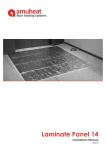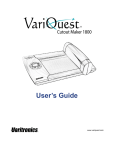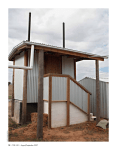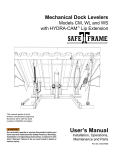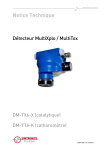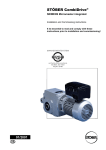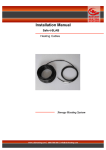Download Thin Cable Mat Installation Manual - Amuheat
Transcript
amuheat floor heating systems Thin Cable Mat Installation Manual TCM02-12 Table of Contents 150watt / 200watt Thin Cable Mat Introduction 1 Thin Cable Mat Important Installation Guidelines 2 Tools & Materials Needed for Installation Kit Contents Glossary of Terms Electrical Requirements 3 Electrical Requirement Thin Cable Mat & Sensor Rough-In Testing & Product Specification 4 Warranty Validation Floor Sensor Resistance Test Insulation Test Thin Cable Mat Heater Specification Installation 5 Subfloor construction Plan heating mat layout Electrical & Floor preparation 6 Position and fix heating mat Modifying Thin Cable Mat 7 Multiple Thin Cable Mat installation Electrical Connection 8 Important Points for the Tiler Curing Time Troubleshooting 9 Checking for breaks Checking for electrical shorts Locating a break or Electrical short Cable repair Warranty 10 Warranty Install Test Record & Warranty Registration Miscellaneous 12 Notes Introduction Please read carefully before proceeding with installation Thin Cable Mat Product Amuheat Thin Cable Mat has been designed and developed to exceed all relevant standards, ensuring installation is quick and simple. It features an ultra thin single conductor 2mm heating cable pre attached to a fibre glass mesh with three adhesive tape strips for fixing to the floor, yet still allowing unlimited adjustment of the heating element to suit any room layout. Experienced product design ensures minimal increase to existing floor levels with an even heat across the complete floor surface. Thin Cable Mat is available in two output types: 150 watts per m² (for use in living rooms, kitchens, bedrooms, etc) 200 watts per m² (for use in bathrooms or living rooms with high heat losses) Important Installation Guidelines Take some time to plan the layout considering all obstacles e.g. kitchen cupboards, bathroom sinks etc. Ensure mat will fit before starting Use flexible tile adhesives and grouts Multiple heating mats connect to the thermostat in parallel - the cold tail leads cannot be joined and buried in the ground If a floor sensor is required, ensure it is inserted in a conduit sealed at the floor end (to ensure easy removal of floor sensor if required after installation) and installed between two heating elements Do not leave surplus matting rolled up under cabinets and do not cut, shorten or lengthen the heating element Maintain a minimum of 50mm between the heating element runs or where heating cable is stripped from the mesh for free form layouts Do not bang a trowel on the floor area with heating element to remove excess mortar from the trowel and do not use a knife to clean adhesive from between the tiles along the grout spacing Take care not to damage the heating element and cold tail whilst tiling Ensure all the blue heating element is covered with a flexible self levelling compound or tile adhesive Make certain there are no air gaps underneath tiled areas or between heating element runs Concrete subfloors must be fully cured before installation commences and timber subfloors must be rigid and free from movement by using a suitable tile backer board (FC Sheet) or insulation board Ensure all the blue heating elements are installed within the floor avoiding crossing the heating element, floor sensor wire or cold tail 1 leads over or under each other and one another Do not drop or rest any heavy objects or tools on the heating element. Do not cut or shorten the blue heating cable Do not leave surplus matting rolled up under cabinets and do not cut, shorten or lengthen the heating element Do not switch your under floor heating system on for a minimum of 7 days after tiling to allow correct curing of tile adhesives and grouts. Make sure all electrical work is done by a qualified electrician and check your electrician provides a mains power supply connected via a RCD circuit Introduction Please read carefully before proceeding with installation Tools & Materials Needed for Installation You will require the following items to install Thin Cable Mat Floor primer (primer supplied with tile adhesive or use other ie.Bondcrete with water 1:4 ratio) Paint tray and roller to apply floor primer Scissors (to cut the fibreglass mesh) Permanent marker or construction crayon Tape measure Chisel & hammer or angle grinder (to recess cold tail joints & conduits in floor) Cardboard or carpet scraps (to protect the heater if tiling is delayed) 2 x 20mm Conduit (one for cold tail leads & one for floor sensor) Wall box, plate or c-clip (for mounting thermostat) RCD switch on electrical board (supplied and fitted by your electrician) You may require a 20A contactor if you are installing multiple heating mats connected to one thermostat where the load capacity exceeds 16A Kit Contents Amuheat Thin Cable Mat heater Element fault monitor Digital Programmable thermostat Floor temperature sensor Installation guide Thermostat operating guide Warranty registration Cable Mat installation guide Thermostat operating guide Glossary of Terms G C E H A I F D J C B Thin Cable Mat Construction Heating Element Profile A Cold tail power lead (active) B Cold tail power lead (neutral) C Factory-made cold tail joint D Floor temperature sensor E Heating element F Fibreglass mesh w/ adhesive strips G Multi strand heating conductor wire H Primary Teflon insulation I Steel earth braid J Thermoplastic polymer insulation 2 Electrical Requirements 150watt / 200watt Thin Cable Mat Electrical Requirement Before installing Thin Cable Mat you should make allowance for the electrical connections (refer to diagram below & electrical schedule supplied with your quote/order). All electrical connections (including thermostats) must be performed by your electrician, in accordance with current AS/NZ 3000 wiring rules. Thin Cable Mat requires a mains voltage 230/240V supply and must be connected to an approved Residual Current Device (RCD) mounted on the switchboard. It is recommended you consult with your electrician to ascertain whether or not the circuit and cabling can handle the additional load and if a RCD is protecting the circuit. If connecting multiple heating mats with an electrical load greater than 16A to one thermostat, you will require a suitably sized electrical contactor. Thin Cable Mat & Sensor - Conduit to power supply on RCD circuit. - Flush box, plate or c-clip for thermostat (height 1200mm - 1500mm). Thermostat model AT908B - Horizontal Thermostat model AT8100V - Vertical Thermostat model AT8100H - Vertical - 20mm Conduit (max 2 heaters) & draw wire pulled through. Refer to electrical schedule for number required - 20mm Conduit for floor sensor & draw wire pulled through (recessed into subfloor) Positioned 250mm in between heating elements - Floor heating system - Cold tail joints recessed into subfloor 3 Testing & Product Specification 150watt / 200watt Thin Cable Mat Warranty Validation Thin Cable Mat is tested and supplied in good working order from our factory. To ensure the integrity of the system, an insulation and resistance test on the heating cable should be conducted before, during and after heater and floor installation. This information should be recorded on the Installation Test Record sheet to validate the 10 year extended manufacturers warranty. Resistance Test This test is carried out to ensure continuity exists in the heating element. Using a multimeter on ohm setting, place one probe on the active conductor and the other on the neutral conductor (brown and blue leads on cold tail) and confirm the resistance value matches the factory test result within +/10% of the value marked on the product specification label and/or table below. Floor Sensor Resistance Test If installing the thermostat floor temperature sensor, test for resistance as above. The range on the multimeter should be set to Auto or 20K Ohm. Resistance readings for AT8100-x thermostat sensors should be between 5-15K Ohm and AT908-x thermostat sensors should be between 100-120K Ohm. Insulation Test This test is performed to measure the insulation resistance between conductors and ensures the cable insulation is not damaged. A low resistance reading indicates a damaged cable and must be repaired or replaced. The insulation resistance tester should be connected between the conductors (blue and brown cables) and the earth braid(yellow/green cable). The meter should set to 500V and record a high resistance value. 200W Code CM200-20 CM300-30 CM400-20 CM500-20 CM600-20 CM700-20 CM800-20 CM900-20 CM1000-20 CM1200-20 Coverage 1m² 1.5m² 2m² 2.5m² 3m² 3.5m² 4m² 4.5m² 5m² 6m² Mat Dimension (m) 2 x 0.5 3 x 0.5 4 x 0.5 5 x 0.5 6 x 0.5 7 x 0.5 8 x 0.5 9 x 0.5 10 x 0.5 12 x 0.5 Watt @ 230V 200 300 400 500 600 700 800 900 1000 1200 Ohm Resistance +10–5% 264 176 132 105 88 75 66 59 53 44 Coverage 5m² 6m² 8m² 10m² 12m² Mat Dimension (m) 10 x 0.5 12 x 0.5 16 x 0.5 20 x 0.5 24 x 0.5 Watt @ 230V 750 900 1200 1500 1800 Ohm Resistance +10–5% 70 59 44 35 29 150W Code CM750-15 CM900-15 CM1200-15 CM1500-15 CM1800-15 4 Installation 150watt / 200watt Thin Cable Mat Step 1 - Subfloor Construction Suitable sub-floors must be correctly designed, constructed and prepared in accordance with building regulations. Thin Cable Mat can be installed on concrete slab, sand cement screed, existing tiles, acoustic underlay, FC Sheet board and above any of these subfloors whose surface is coated with a waterproof. F F E E D D B H C G A Thin Cable Mat On Concrete/Screed Subfloor A B C D E F G H Concrete/Screed Subfloor Insulation (optional) Glue Thin Cable Mat Tile Glue Tile Floor Finish Timber Subfloor Tile backer board (FC Sheet) Thin Cable Mat On Timber Subfloor Our recommendation is only intended to provide an outline guide of suitable subfloors and preparation work required before installing Thin Cable Mat. Step 2 - Plan heating mat layout Plan your heating mat layout by drawing your room including all fixed items e.g. toilet sink kitchen benches etc, then confirm the heating mat you have purchased matches the floor area to be heated. From the thermostat position (start point) sketch the proposed layout to ensure the heated area is completely covered whilst using all of Thin Cable Mat. Plan the layout to return the end of the heating mat back to the start point. Also, keep 100mm away from all walls & permanent fixtures and allow a buffer around the perimeter to accommodate heater cold tail leads that may need to return to the start point. Step 3 - Electrical & floor preparation Thin Cable Mat is supplied with two cold tail leads which should run from the floor to the thermostat in a single 20mm conduit (limit 2 heating mats per conduit). A separate conduit is required, extended and positioned to lay between two heating cables, for the thermostat floor sensor. The heater cold tail joints and conduits should be placed in a channel to allow the conduits and cold tail joints to remain flush with the existing floor and the floor sensor conduit should be sealed to prevent adhesive or self levelling screed entering it. Refer to Electrical Requirements. Prepare the floor by removing all loose particles thoroughly and seal with primer supplied with tile glue (or Bondcrete mixed 1:4 with water). 5 Installation 150watt / 200watt Thin Cable Mat Step 4 - Position & fix heating mat Starting from the floor directly beneath the thermostat location, unroll the heating mat until you reach the end of your first run. Ensure the heating mat is placed on the floor with the heating cable underneath the mesh (see page 7 for more info on modifying Thin Cable Mat). When you reach the end of the first run carefully cut the mesh in between two heating cables (do not cut the blue heating cable) and turn the mat to its new position. Ensure the cable remains a minimum of 50mm apart and the mesh does not overlap. Continue this process. In some instances it may be necessary to free form the heating cable around fixtures and fittings by cutting the heating cable and mesh free from long runs. Ensure the heating cable is laid at a minimum of 50mm apart. When you are close to completing the layout of the heating mat where the end of the heating mat is a distance from the start point, remove enough heating cable from the mesh/tape to return along the side of the heating mat to position the cold tail joint and cold tail lead at the start point. Cut U-Turn Turn Flip Cut & Remove Mesh Free-form Obstacle 6 Installation 150watt / 200watt Thin Cable Mat If you are installing multiple heaters into one room and using one thermostat, you will need to ensure all the cold tail leads start and finish at the same point. Do not join the cold tail leads or heating elements wire together. 28 24 25 2021 1617 1415 10 11 6 7 2 3 34 30 31 26 27 12 13 2627 23 22 1819 9 4 5 1 32 33 8 3 2 5 4 7 6 9 8 11 10 14 13 12 15 19 18 28 23 22 29 25 24 21 20 17 16 1 T Once complete, remove the backing off the tape and stick the heating mat to the floor including free form runs as required. Step 5 - Electrical Connection The included thermostat is supplied with a floor sensor, whose tip needs to fed into a conduit and fixed between two heating cables (conduit may need to be recessed into the subfloor). Before tiling commences, test the heating mats to ensure they are working correctly. Then connect the element fault monitor to the heating mat power cable to monitor for damage during the carpet installation. FOR MULTIPLE MAT INSTALLATIONS, NEVER JOIN THE POWER SUPPLY CABLES UNDER THE TILE FLOOR. NO SERIAL CONNECTIONS OF ONE MAT TO ANOTHER PANEL. NO DAISY-CHAINS. A QUALIFIED ELECTRICIAN MUST CONNECT THE POWER SUPPLY CABLES TO THE THERMOSTAT, AND CONNECT THE THERMOSTAT TO THE SUPPLY. Note These installation instructions are NOT intended to replace or supersede the installation instructions provided by the manufacturer of tile or adhesives, but to supplement them. BOTH sets of installation instructions should be complied with. In the event of any apparent contradiction between instructions, contact Amuheat for clarity on how to proceed. 7 Installation 150watt / 200watt Thin Cable Mat Important Points for the Tiler Ensure the heating element monitor is connected to the heating system and switched on before tiling. Stop all works if the alarm is sounding or the red light is on. Ensure you use tile adhesives and grouts suitable for use with underfloor heating systems (they must contain a flexible additive). It is important that each tile is solidly bedded in tile adhesive, with no gaps or voids beneath them. Avoid unnecessary foot traffic. Heavy cardboard or carpet scraps should be used to protect the heating cables from traffic during the floor installation. For best results, cover the heating mat with a flexible floor leveling compound. Avoid unnecessary foot traffic Do not scrape out grout below the tile bottom When installing mosaic tiles and certain porcelain tiles, we recommend covering the heating mat with a flexible floor leveling compound before tiling to ensure a flat smooth surface. Where a sand cement screed is applied on top of the heating element, the extra protection offered by the flexible floor leveling compound over the heating mat, or for tiling mosaic and certain porcelain tiles is not required. Do not use ladders Care should be taken to not damage the heating cable if bedding or leveling the sand cement mixture over Thin Cable Mat. Apply a layer of tile adhesive (minimum 10mm) over the heating mat and lay the tile or stone directly into this layer of tile adhesive. Avoid careless use of the trowel. This can cause damage to the heating cable, so avoid placing, dropping or banging tools directly on the heating element. No heavy or sharp objects. Do not use one trowel to lift tiles, use two. Do not scrape out grout from below the tile bottom as this will cut the heating element below. Use a wet sponge and blunt object. Avoid mixing or shoveling the sand cement mixture over the heating cable. Do not use one trowel to lift tiles, use two. Avoid using wheelbarrows over the heating mat. Curing Time Ceramic tile and stone installations require up to 14 days for the adhesive to cure. You must allow the adhesive to fully cure before the floor heating system is switched on. Failure to do so may result in damage to the heating cable and cause the adhesive to become brittle. 8 Troubleshooting 150watt / 200watt Thin Cable Mat Checking For Breaks To determine if there is a break in the heating cable under the floor: l Set the multimeter to measure in 0-200 Ohms. l Place one probe on the active conductor and the other on the neutral conductor. h Confirm your reading falls within +/- 15% of the recorded value before installation. h If you have absolutely no reading (= infinity on your meter), then there is a break (= total cut) in the conductor. Checking For Electrical Short To determine if there is a short in the heating cable under the floor: l Set the multimeter to measure in 0-200 Ohms. l Place one probe on the active conductor and the other on the corresponding earth wire. h Confirm your reading is open circuit or infinity. h Repeat this step on the neutral conductor and it’s corresponding earth wire. h Place one probe on the active conductor and the other on the active earth wire. h If you have continuity between either the active-earth or neutral-earth combinations, there is a short in the heating cable. Locating a Break or Electrical Short There are several ways to locate breaks or circuit shorts mathematically or with underground fault detectors. For more information, contact Amuheat Support. Cable Repair l l l l l l l l l l l 9 Cut the damaged piece of heating cable out Using a knife blade, carefully strip the outer PVC layer from both ends of the exposed heating cable. Separate and twist the earth core away from the inner conductor on both ends of the exposed heating cable. Using an open flame, burn the inner Teflon layer from the conductor wire from both ends of the exposed heating cable. Measure the length of electrical wire required to join the two exposed ends of the heating cable, and using the knife blade, strip away some of the insulation. Using a ferule or solder connect the one end of the heating cable conductor to a piece of electrical wire. Slide a piece of heat shrink over the join, and seal under an open flame. Slide a second piece of heat shrink over the electrical wire. Using a second ferrule or solder, connect the other end of the electrical wire to the other exposed heating cable conductor. Slide the second piece of heat shrink over the join and seal under an open flame. Repeat these steps to repair the earth wire. Conduct resistance and insulation tests on the heating cable prior to connection. Compare the results with those taken before, during and after the heating and flooring installation. Recess the join in a chiseled channel and cover with hot glue melt. Warranty 150watt / 200watt Thin Cable Mat Warranty Thin Cable Mat is supported by a 1 year manufacturers warranty from the date of purchase. An extended 10 year manufacturers warranty is offered by registering your purchase and installation below. Where it is determined Thin Cable Mat is defective in material, and has not been damaged as a result of misuse or misapplication, Amuheat will repair or replace the heating mat. If the repair is not feasible, Amuheat will at their discretion replace or refund the original cost of the heating mat. The warranty does not cover faults caused by incorrect design by others / misuse / damage caused by others / damage in transit / incorrect installation and any other subsequent damage that may occur. Repair / replacement will be fully chargeable if the damage is because of any of the above reasons. Amuheat disclaims any warranty not provided herein. Amuheat futher disclaims any responsibility for any consequential damages arising from ownership or use of the product, including inconvenience, loss of use and costs of operating the heating mat. The guarantee is a material warranty only and does not cover field labour. To validate the extended 10 year manufacturers warranty, the following conditions must be met: The Install control card & Warranty Card must be completed and returned to Amuheat within 60 days of purchase Proof of purchase will be required in the event of a claim - retain your receipt Installation is in accordance with the accompanying Installation Manual, any special written design or installation guidelines provided by Amuheat and all local and building and electrical codes The heater has been earthed and connected to a supply protected by a RCD circuit The heater is used with a thermostat or control system approved by Amuheat Install Test Record & Warranty Registration Complete form below and mail to Amuheat, PO Box 975, North Ryde BC 1611 or fax copy to (02) 8211 5180. Installer Name Phone Email Owner Name Address Phone Email Purchase Detail Date of purchase Heater Install Test Records Heater Model Test Continuity Resistance (Ohms) Insulation Resistance (Mohms) Invoice Number Installation Date Before Install After Install After Floor Install 10 Notes 150watt / 200watt Thin Cable Mat 12 amuheat floor heating systems © 2012 Amuheat Pty Limited Lg1 64 Talavera Road Macqaurie Park NSW 2113 PO Box 975 North Ryde BC NSW 1611 Tel: (02) 9114 6934 Fax: (02) 8211 5180 [email protected] www.amuheat.com.au

















